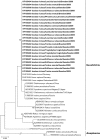Candidatus Neoehrlichia mikurensis in Ticks from Migrating Birds in Sweden
- PMID: 26207834
- PMCID: PMC4514885
- DOI: 10.1371/journal.pone.0133250
Candidatus Neoehrlichia mikurensis in Ticks from Migrating Birds in Sweden
Abstract
Candidatus Neoehrlichia mikurensis (CNM; family Anaplasmataceae) was recently recognized as a potential tick-borne human pathogen. The presence of CNM in mammals, in host-seeking Ixodes ticks and in ticks attached to mammals and birds has been reported recently. We investigated the presence of CNM in ornithophagous ticks from migrating birds. A total of 1,150 ticks (582 nymphs, 548 larvae, 18 undetermined ticks and two adult females) collected from 5,365 birds captured in south-eastern Sweden was screened for CNM by molecular methods. The birds represented 65 different species, of which 35 species were infested with one or more ticks. Based on a combination of morphological and molecular species identification, the majority of the ticks were identified as Ixodes ricinus. Samples were initially screened by real-time PCR targeting the CNM 16S rRNA gene, and confirmed by a second real-time PCR targeting the groEL gene. For positive samples, a 1260 base pair fragment of the 16S rRNA gene was sequenced. Based upon bacterial gene sequence identification, 2.1% (24/1150) of the analysed samples were CNM-positive. Twenty-two out of 24 CNM-positive ticks were molecularly identified as I. ricinus nymphs, and the remaining two were identified as I. ricinus based on morphology. The overall CNM prevalence in I. ricinus nymphs was 4.2%. None of the 548 tested larvae was positive. CNM-positive ticks were collected from 10 different bird species. The highest CNM-prevalences were recorded in nymphs collected from common redpoll (Carduelis flammea, 3/7), thrush nightingale (Luscinia luscinia, 2/29) and dunnock (Prunella modularis, 1/17). The 16S rRNA sequences obtained in this study were all identical to each other and to three previously reported European strains, two of which were obtained from humans. It is concluded that ornithophagous ticks may be infected with CNM and that birds most likely can disperse CNM-infected ticks over large geographical areas.
Conflict of interest statement
Figures

Similar articles
-
"Candidatus Neoehrlichia mikurensis" in Ixodes ricinus ticks collected near the Arctic Circle in Norway.Parasit Vectors. 2018 Dec 4;11(1):620. doi: 10.1186/s13071-018-3168-y. Parasit Vectors. 2018. PMID: 30514355 Free PMC article.
-
Candidatus Neoehrlichia mikurensis in ticks and rodents from urban and natural habitats of South-Western Slovakia.Parasit Vectors. 2016 Jan 4;9:2. doi: 10.1186/s13071-015-1287-2. Parasit Vectors. 2016. PMID: 26728197 Free PMC article.
-
Presence of Candidatus Neoehrlichia mikurensis and Babesia microti in rodents and two tick species (Ixodes ricinus and Ixodes trianguliceps) in Slovakia.Ticks Tick Borne Dis. 2016 Mar;7(2):319-26. doi: 10.1016/j.ttbdis.2015.11.008. Epub 2015 Nov 26. Ticks Tick Borne Dis. 2016. PMID: 26700195
-
Neoehrlichiosis - a new tick-borne disease - is there a threat in Poland?Przegl Epidemiol. 2015;69(1):23-6, 131-3. Przegl Epidemiol. 2015. PMID: 25862443 Review. English, Polish.
-
Neoehrlichiosis: an emerging tick-borne zoonosis caused by Candidatus Neoehrlichia mikurensis.Exp Appl Acarol. 2016 Mar;68(3):279-97. doi: 10.1007/s10493-015-9935-y. Epub 2015 Jun 17. Exp Appl Acarol. 2016. PMID: 26081117 Review.
Cited by
-
Association between guilds of birds in the African-Western Palaearctic region and the tick species Hyalomma rufipes, one of the main vectors of Crimean-Congo hemorrhagic fever virus.One Health. 2021 Nov 11;13:100349. doi: 10.1016/j.onehlt.2021.100349. eCollection 2021 Dec. One Health. 2021. PMID: 34825045 Free PMC article.
-
Pathogen communities of songbird-derived ticks in Europe's low countries.Parasit Vectors. 2017 Oct 18;10(1):497. doi: 10.1186/s13071-017-2423-y. Parasit Vectors. 2017. PMID: 29047399 Free PMC article.
-
First Records of Possibly Human Pathogenic Rickettsia Species in Bat Ticks, Carios vespertilionis, in Sweden.Microorganisms. 2023 Jan 31;11(2):357. doi: 10.3390/microorganisms11020357. Microorganisms. 2023. PMID: 36838322 Free PMC article.
-
"Candidatus Neoehrlichia mikurensis" in Ixodes ricinus ticks collected near the Arctic Circle in Norway.Parasit Vectors. 2018 Dec 4;11(1):620. doi: 10.1186/s13071-018-3168-y. Parasit Vectors. 2018. PMID: 30514355 Free PMC article.
-
Investigation of erythema migrans patients identifies Borrelia species and Neoehrlichia mikurensis with implications for clinical assessment.Sci Rep. 2025 Jun 25;15(1):20293. doi: 10.1038/s41598-025-07291-0. Sci Rep. 2025. PMID: 40562820 Free PMC article.
References
-
- Kawahara M, Rikihisa Y, Isogai E, Takahashi M, Misumi H, Suto C, et al. Ultrastructure and phylogenetic analysis of 'Candidatus Neoehrlichia mikurensis' in the family Anaplasmataceae, isolated from wild rats and found in Ixodes ovatus ticks. Int J Syst Evol Microbiol. 2004;54(Pt 5):1837–43. - PubMed
-
- Grankvist A, Andersson PO, Mattsson M, Sender M, Vaht K, Hoper L, et al. Infections with the tick-borne bacterium "Candidatus Neoehrlichia mikurensis" mimic noninfectious conditions in patients with B cell malignancies or autoimmune diseases. Clin Infect Dis. 2014;58(12):1716–22. 10.1093/cid/ciu189 - DOI - PubMed
Publication types
MeSH terms
Substances
LinkOut - more resources
Full Text Sources
Other Literature Sources
Molecular Biology Databases
Research Materials

